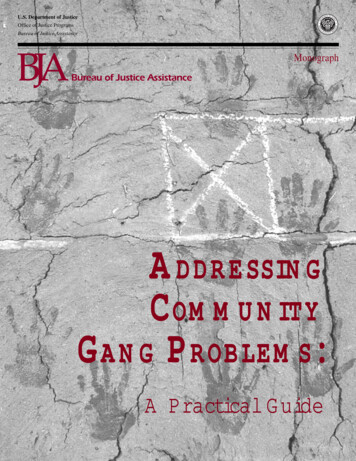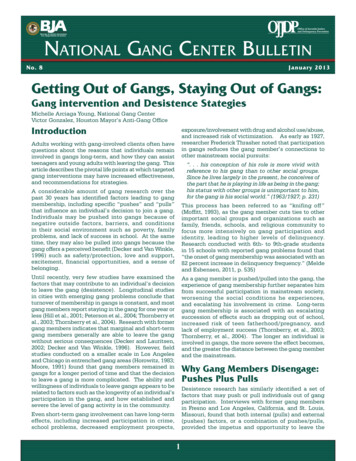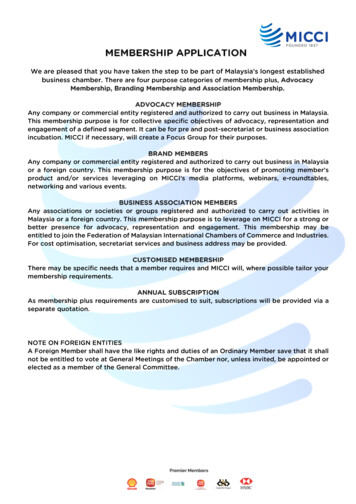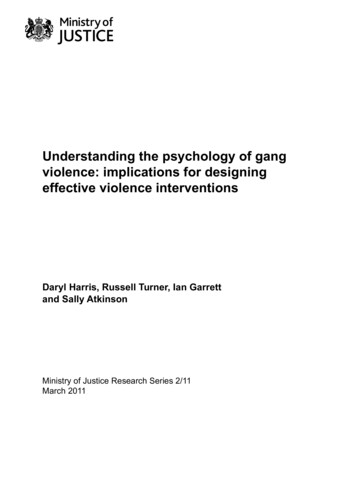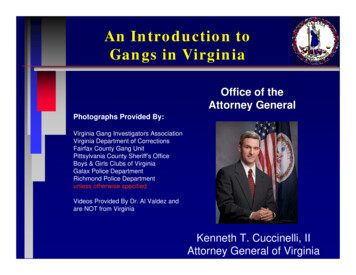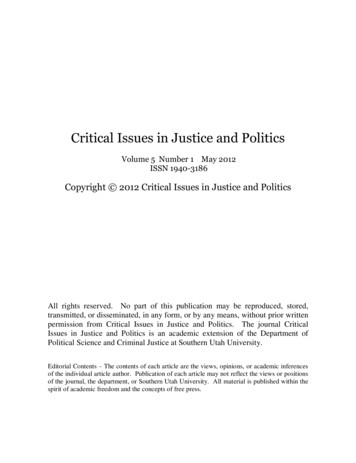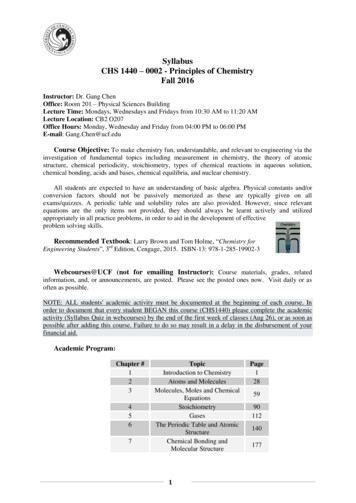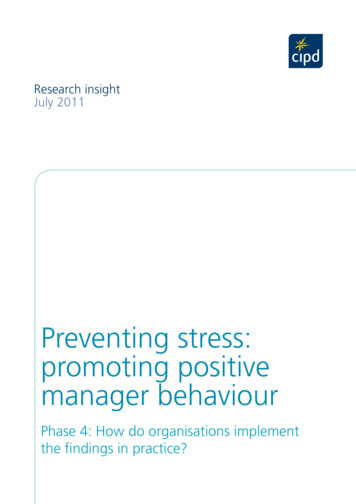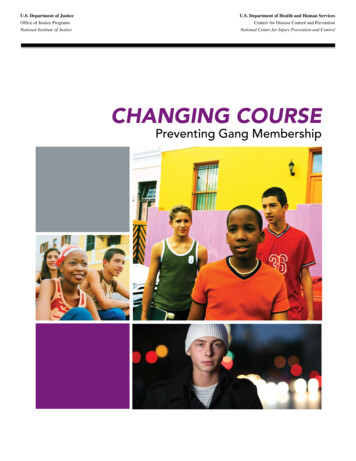
Transcription
U.S. Department of JusticeOffice of Justice ProgramsNational Institute of JusticeU.S. Department of Health and Human ServicesCenters for Disease Control and PreventionNational Center for Injury Prevention and ControlCHANGING COURSEPreventing Gang Membership
U.S. Department of JusticeU.S. Department of Health and Human ServicesOffice of Justice ProgramsCenters for Disease Control and Prevention810 Seventh Street N.W.1600 Clifton RoadWashington, DC 20531Atlanta, GA 30333Office of Justice ProgramsCenters for Disease Control and PreventionInnovation Partnerships Safer NeighborhoodsCDC 24/7: Saving Lives, Protecting People www.OJP.govwww.CDC.gov
CHANGING COURSEPreventing Gang MembershipEditorsThomas R. Simon, Ph.D., Deputy Associate Director forScience, Division of Violence Prevention, Centers for DiseaseControl and PreventionNancy M. Ritter, Writer and Editor, National Institute of JusticeReshma R. Mahendra, M.P.H., Public Health Advisor, Divisionof Violence Prevention, Centers for Disease Control andPrevention
AcknowledgmentsLike most good partnerships, the one that resulted in this book was sparked by two thoughtleaders who wanted to push some envelopes. In 2008, Phelan Wyrick, Ph.D. (now a senior advisor to the Assistant Attorney General for DOJ’s Office of Justice Programs) was an NIJ programmanager when he picked up the phone and called Dr. Rodney Hammond, then the Director ofthe Division of Violence Prevention at the Centers for Disease Control and Prevention. Wyrickpitched his idea: ‘We know that youth gangs contribute disproportionately to crime and violence so let’s put some good public health and criminal justice minds to work on determining waysto stop kids from joining gangs in the first place.’ Always a champion of prevention, Hammondimmediately saw the advantages of this collaboration. The editors of this book — who turnedthat vision into print, Web, and ebook — thank them for their inspiration. Our thanks also go toLouis Tuthill, Ph.D. (a social scientist formerly with NIJ) and Winifred L. Reed (Director of NIJ’sCrime, Victimization and Violence Research Division), who were instrumental in envisioning thestructure of the book, recruiting the authors and reviewing early drafts of the chapters. Finally,our thanks go to Linda Dahlberg, Ph.D., Associate Director for Science at CDC’s Division of Violence Prevention, for her support from the beginning.—— The EditorsThe conclusions in these chapters are those of the authors and do not necessarily represent the official position of the Centers for DiseaseControl and Prevention or of the National Institute of Justice.
Table of ContentsAcknowledgments .iiIntroduction . 11. Why Is Gang-Membership Prevention Important? . 7James C. Howell2. The Attraction of Gangs: How Can We Reduce It?. 19Carl S. Taylor and Pamela R. Smith3. What Is the Role of Public Health in Gang-Membership Prevention? . 31Tamara M. Haegerich, James Mercy and Billie Weiss4. What Is the Role of Police in Preventing Gang Membership? . 51Scott Decker5. How Should We Identify and Intervene With Youth at Risk of Joining Gangs? . 63Nancy G. Guerra, Carly B. Dierkhising and Pedro R. Payne6. What Should Be Done in the Family to Prevent Gang Membership? . 75Deborah Gorman-Smith, Andrea Kampfner and Kimberly Bromann7. What Can Schools Do to Help Prevent Gang-Joining? . 89Gary D. Gottfredson8. What Should Be Done in the Community to Prevent Gang-Joining?. 105Jorja Leap9. How Can We Prevent Girls From Joining Gangs? . 121Meda Chesney-Lind10. Race and Ethnicity: What Are Their Roles in Gang Membership? . 135Adrienne Freng and Terrance J. Taylor11. Program Evaluation: How Do We Know If We Are Preventing Gang Membership? . 151Finn-Aage Esbensen and Kristy N. MatsudaConclusion: An Invitation to Contribute to Gang-Joining Prevention . 163 iii
IntroductionYouth gang membership is a serious and persistent problem in the United States. One in three local law enforcement agencies report youth gang problems in their jurisdictions.1 One in four highschool freshmen report gangs in their schools.2 Limited resources at the national, state, tribal andlocal levels make it more important than ever that we make full use of the best available evidence andclearly demonstrate the benefit of strategies to prevent gang-joining.In acknowledgment of these realities, the Centers for Disease Control and Prevention (CDC) and the National Institute of Justice (NIJ) formed a partnership to publish this book. It is critical that those who makedecisions about resources — as well as those who work directly with youth, like teachers and policeofficers, community services providers and emergency department physicians — understand what theresearch evidence shows about how to prevent kids from joining gangs.The NIJ-CDC partnership drew on each agency’s distinctive strengths: NIJ’s commitment to enhancingjustice and increasing public safety is matched by CDC’s dedication to health promotion and preventionof violence, injury and disability. By combining perspectives, lessons and evidence from public safety andpublic health, NIJ and CDC provide new insights into the complex problems of gangs and gang membership.Public health and public safety workers who respond to gang problems know that after-the-fact effortsare not enough. An emergency department doctor who treats gang-related gunshot wounds or a policeofficer who must tell a mother that her son has been killed in a drive-by shooting are likely to stress theneed for prevention — and the complementary roles that public health and law enforcement must play —in stopping violence before it starts.Given our shared commitment to informing policy and practice with the best available evidence ofwhat works, CDC and NIJ brought together some of the nation’s top public health and criminal justiceresearchers to present core principles for gang-membership prevention.Why Are Principles So Important?It would seem to go without saying that we should try to prevent kids from joining gangs. But why publish an entire book on principles rather than just a straightforward recipe for preventing gang-joining?There are at least four reasons to focus on principles of prevention:1. Much of what we know about preventing gang membership is drawn from research in other prevention fields, such as juvenile delinquency and violence prevention.2. Joining a gang is a complex process that involves both individual volition and social influences; therefore, it is difficult to imagine that a single “recipe” for preventing gang membership would be effectivefor all at-risk youth across the array of social contexts.3. Our focus on prevention principles better equips us to confront the specific public health and publicsafety issues linked to gang membership: interpersonal violence, truancy and school dropout, alcoholand substance abuse, and a host of related crime and health challenges.4. By emphasizing principles, we seek to move the public discourse beyond an overly simplistic notion ofgangs and gang problems — in an effort to cultivate an understanding of the complex array of socialpatterns and individual behaviors that are encountered under the rubric of “gangs.” 1
I N T RO D U C T IO NThe consequences of gangs — and the burden they place on the law enforcement and health systems inour communities — are significant. The simple truth, however, is that gang intervention and suppressionactivities and strategies for providing medical services to gang members and victims of gang violence,although critical, are not enough. We must implement early prevention strategies to keep youth fromjoining gangs in the first place. Indeed, we believe that, faced with current economic realities, prevention is the smartest, most economical approach to solving the gang problem and its cascading impact onindividuals, families, neighborhoods and society at large.Consider the impact of violence. In the U.S., homicide is the second leading cause of death amongadolescents and young adults: it results in an average of 13 deaths every day among those ages 10-24.3However, the number of violent deaths tells only part of the story: More than 700,000 young people aretreated in U.S. emergency departments for assault-related injuries each year.3 Violence also erodes communities by reducing productivity, decreasing property values and disrupting social services.Now, consider the impact of gangs on violence and other crime. Youth involved in gangs are far morelikely than youth not involved in gangs to be both victims and perpetrators of violence.4, 5 In many U.S.communities, gang members (including youth and adult members of street, outlaw motorcycle andprison gangs) are responsible for more than half of the violent crimes and, in some jurisdictions, gangmembers are responsible for 90 percent of violent crimes.6The consequences of youth gang membership extend beyond the risk for crime and violence. Ganginvolved youth are more likely to engage in substance abuse and high-risk sexual behavior and to experience a wide range of potentially long-term health and social consequences, including school dropout,teen parenthood, family problems and unstable employment.7Why Prevention?The goal of this book is to provide practitioners and policymakers with knowledge about why kids become involved in gangs and to offer effective and promising strategies that prevent them from doing so.A significant proportion of local, state and federal budgets — in health, criminal justice, law enforcementand community services — is dedicated to dealing with gang-joining and its sequelae after it has occurred. We also know that a large majority of youth who join gangs do so very young — between ages11 and 15 — and the peak ages for gang-joining are between 13 and 15 years old.8Fortunately, we know that many early prevention programs provide taxpayers with significantly morebenefits than costs. Nobel Prize-winning economist James Heckman, for example, has written aboutthe economic benefits of targeting high-risk children before they start kindergarten.9 Researchers at theWashington State Institute for Public Policy have done cost-benefit analyses of programs that showsignificant effects on a range of outcomes, including crime, educational attainment, substance abuse,child abuse and neglect, teen pregnancy and public assistance. One example is the Nurse-Family Partnership, which provides support during pregnancy to low-income women and helps them develop parentingskills during the child’s first two years of life. Evaluations of the long-term effects of this program showsignificant reductions in child neglect and abuse, and sustained effects on the child through age 15,including less likelihood of running away, reduced alcohol consumption, and 56 percent fewer arrests.The Nurse-Family Partnership is estimated to provide 2.37 return on every dollar invested, resulting inapproximately 13,181 in savings per child.10Although such cost-benefit data provide decision-makers with the fiscal rationale for implementing earlyprevention programs, it is also important to consider the ethical responsibility that communities have tohelp children avoid gang membership. That said, no one who reads this book will be surprised to learnthat there is no quick fix. Reducing gang activity and violence requires a combination of strategies, including prevention, enforcement and reentry services for those returning from confinement. Preventing gangmembership in the first place holds promise for long-term success in reducing both violence and crimeand the “downstream” societal problems that stem from gang activities. 2
CHAN GIN G COURSEWhat You Will LearnLittle scientific evidence specifically addresses gang-membership prevention; however, the body ofresearch on youth delinquency and youth violence offers substantial insights. Where research specific togang-joining exists, the experts who worked on this book discuss it, but we also asked them to considerresearch on youth violence, delinquency, developmental ecology and substance use to explore promisingprinciples for gang-membership prevention.We begin with a chapter by a pioneer in the field of youth gangs, James (“Buddy”) Howell. Examining whypreventing gang-joining is so important, Dr. Howell discusses the latest information about the magnitudeand seriousness of the gang problem in the U.S. In chapter 2, Dr. Carl Taylor and Ms. Pamela Smith discuss aspects of gang life that are attractive to some youth. This chapter considers the perceptions thatan adolescent may have about the personal, economic and social motives for joining a gang.In chapter 3, Dr. Tamara Haegerich, Dr. James Mercy and Ms. Billie Weiss explore the public healthimpact of gang membership, and they encourage readers to consider the complementary roles of publichealth and law enforcement in helping to prevent kids from joining a gang. In chapter 4, Dr. Scott Deckerdescribes the role that law enforcement can play in preventing youth from joining a gang and recommends an emphasis on prevention rather than suppression-only tactics. Together, these two chaptershighlight the importance of collaboration and coordination across sectors, including health, law enforcement, education and business.The next four chapters are structured according to the social ecological model for designing preventionstrategies.The social ecological model posits multiple levels at which risk factors can be reduced and protectivefactors can be enhanced — moving from within individuals and relationships to an entire communityor society at large (see graphic, “Levels of Social Influence on Youth Violence: The Social EcologicalModel”). First, in chapter 5, Dr. Nancy Guerra and colleagues describe the individual and family factors inearly childhood (ages 0-5) and the elementary school years (ages 6-12) that increase the risk for gangjoining. They also explore opportunities for prevention when at-risk youth are identified and provided withage-appropriate prevention strategies that help them avoid a cascade of problems, including gang-joining,delinquency and violence. In chapter 6, Dr. Deborah Gorman-Smith and colleagues focus on how earlyprevention strategies increase the protective role of families by enhancing consistent and appropriateLevels of Social Influence on Youth Violence: The Social Ecological : Dahlberg LL, Krug EG. Violence — A global public health problem. In: Krug EG, Dahlberg LL, Mercy JA, Zwi AB, Lozano R,eds., World Report on Violence and Health. Geneva, Switzerland: World Health Organization, 2002. 3
I N T RO D U C T IO Ndiscipline, monitoring, communication and warmth. In chapter 7, Dr. Gary Gottfredson describes theneed for strategies to enhance the willingness — and ability — of schools to assess gang problems accurately, implement prevention strategies, and address the fear in schools that contributes to the risk forgang-joining. In chapter 8, Dr. Jorja Leap emphasizes the opportunity to build on existing strengths withincommunities. She describes the need for community-based, multifaceted prevention efforts that workacross the life span and are grounded in collaboration among the various stakeholders.As the editors of this book, we felt strongly that — in addition to describing principles for gang-membershipprevention at the individual, family, school and community levels — it was incumbent on us to considerhead-on the need to reduce gang-joining among girls and the issues of race and ethnicity. In chapter 9,Dr. Meda Chesney-Lind explores how we can prevent girls from joining gangs. Her discussion includesthe risks of child sexual abuse, poor family functioning, neighborhood safety, substance abuse and datingviolence. In chapter 10, Drs. Adrienne Freng and T.J. Taylor look at the complex role that race and ethnicity can play in gang membership. Although there is no doubt that more research is needed in this area,they argue that, at this point, common underlying risk factors — such as poverty, challenges for immigrants, discrimination and social isolation — should be our focus.In chapter 11, Drs. Finn Esbensen and Kristy Matsuda examine a subject that is critical to those responsible for making decisions about how limited resources for gang-membership prevention are allocated.Everyone — from federal and state policymakers to local school board members, and from health departments to police departments — is eager to answer the question: “How do we know if we are preventinggang membership?” Anecdotal success stories do not justify creating a new program or continuing theinvestment in an ongoing one. Decisions should be made on the best available evidence. We believe thatit is crucial for decision-makers to understand the key principles of process, outcome and cost-effectiveness evaluations offered in this chapter.Finally, in our Conclusion, we extend an invitation to policymakers and practitioners to engage in a newway of thinking about the intersection of public health and public safety strategies and leveraging publichealth and public safety resources. As a collaboration of international experts recently noted, “It maynot be an easy invitation to accept.”11 We are accustomed to attacking problems such as gang-joiningthrough “silos.” These silos can exist in all levels of government and can be fairly entrenched. So, in addition to facing our nation’s economic challenges, we must start breaking down silos — silos of thinking,silos of action. With this goal in mind, the Conclusion offers suggestions for strategic actions that canhelp prevent kids from joining a gang.Making Research Useful to Practitionersand PolicymakersThe chapters in this book have these common features to help readers determine what information may bemost important to them, see the most critical information up front, and begin to connect research with realworld applications: The titles are framed as questions. Key principles are presented in bulleted form. An “In Brief” summary pulls together key findings and ideas. A Q&A interview with a practitioner offers a personalized illustration of the principles discussed. Implementation and policy challenges are explored. 4
CHAN GIN G COURSEThe need to move beyond silos is one of the reasons we brought together diverse perspectives: publichealth and law enforcement, researchers and practitioners. Criminal justice and public health can collaborate at multiple levels to raise awareness about the importance of early prevention in helping to keepyouth from joining gangs and to ensure that the best available evidence of what works is identified andfully used.This book provides a foundation for that collaboration by describing the principles and promising practicesfor preventing gang-joining that practitioners and policymakers can use to guide decisions and long-termplanning for reducing gang activity. NIJ and CDC are dedicated to this mission, and we hope that this collaboration will serve as an example of the way forward.Vocabulary: Some Basic DefinitionsVocabulary can be a stumbling block for collaboration across sectors. To help avoid confusion and tofacilitate consistency across chapters, we established a few basic operational definitions. In the same waythat this book attempts to help break down silos between criminal justice and public health, we tried toremove some of the jargon that might get in the way of policymakers and practitioners understanding andembracing the principles in this book. Here, then, is some general guidance about what we mean when weuse these terms:Youth gang: Although there is no standard definition of what constitutes a gang, one of our authors, JamesC. (“Buddy”) Howell, has offered a practical definition, which incorporates several widely accepted criteriafor classifying a group as a youth gang:12 Five or more members. Members share an identity, often linked to a name and other symbols. Members view themselves as a gang and are recognized by others as a gang. The group has some permanence and a degree of organization. The group is involved in an elevated level of delinquent or criminal activity.Gang-joining: We use an operational perspective to define this as when a youth self-identifies as amember of a gang.Gang-membership/Gang-joining prevention: This is the implementation of a strategy, program or policythat has the direct or indirect effect of reducing youth’s risk of joining a gang. We use the term primary prevention to refer to preventing youth from joining a gang in the first place. We include strategies that eitherreduce known risk factors or enhance protective factors that reduce the likelihood of gang-joining.Evidence: Principles or assertions made by the authors of the chapters in this book are based on systematic research. We have endeavored to ensure that an evaluation exists to support statements of effectiveness and that the rigor of an evaluation qualifies the strength of statements about a program’s or principle’seffectiveness. We have tried to ensure that the authors avoided (1) statements of opinion or observationthat are not based on systematic research, (2) assessments or discussions of a strategy’s effectivenessthat are not based on an evaluation, and (3) overstatement of confidence in the results of evaluation. 5
I N T RO D U C T IO NEndnotes1. Egley A Jr, Howell JC. Highlights of the 2010 National Youth Gang Survey. Washington, DC: U.S. Department of Justice, Office of Justice Programs, Office of Juvenile Justice and Delinquency Prevention,2012.2. Robers S, Zhang J, Truman J. Indicators of School Crime and Safety: 2011 (NCES 2012-002/NCJ236021). Washington, DC: U.S. Department of Education, National Center for Education Statistics, andU.S. Department of Justice, Office of Justice Programs, Bureau of Justice Statistics, 2012.3. Centers for Disease Control and Prevention. Web-based Injury Statistics Query and Reporting System(WISQARS) [online]. Centers for Disease Control and Prevention, National Center for Injury Preventionand Control, 2009. Available at http://www.cdc.gov/injury/wisqars/index.html. Accessed on September6, 2012.4. Thornberry TP, Krohn MD, Lizotte AJ, Smith CA, Tobin K. Gangs and Delinquency in DevelopmentalPerspective. New York, NY: Cambridge University Press, 2003.5. Peterson D, Taylor TJ, Esbensen F-A. Gang membership and violent victimization. Justice Quarterly2004; 21:793-815.6. Federal Bureau of Investigation. National Gang Threat Assessment: Emerging Trends; 2011. Availableat 1-national-gang-threat-assessment. This report isbased on data from the National Drug Intelligence Center (through the National Drug Threat Survey),the U.S. Bureau of Prisons, state correctional facilities and the National Gang Intelligence Center lawenforcement partners.7. Krohn MD, Ward JT, Thornberry TP, Lizotte AJ, Chu R. The cascading effects of adolescent ganginvolvement across the life course. Criminology 2011; 49:991-1028.8. Howell JC. Gang Prevention: An Overview of Research and Programs. Washington, DC: U.S. Department of Justice, Office of Justice Programs, Office of Juvenile Justice and Delinquency Prevention,2010.9. Heckman J. Skill formation and the economics in investing in disadvantaged children. Science 2006;312:1900-1902.10. Lee S, Aos S, Drake E, Pennucci A, Miller M, Anderson L. Return on investment: Evidence-basedoptions to improve statewide outcomes (Document No. 12-04-1201). Olympia, WA: Washington StateInstitute for Public Policy, April 2012.11. Violence Prevention: An Invitation to Intersectoral Action. Jointly published by the National Instituteof Justice, Cardiff University, The Scottish Government, the Violence Prevention Alliance and the WorldHealth Organization. Available at ectoral action.pdf.12. Howell JC. Gangs in America’s Communities. Thousand Oaks, CA: Sage Publications, 2012. 6
Why Is Gang-Membership Prevention Important?James C. Howell Gangs are a serious, persistent problem in the United States; according to the National YouthGang Survey, from 2002 to 2010 the estimated number of youth gangs increased by nearly 35percent — from 21,800 to 29,400 nationwide. Because high-rate gang offenders impose enormous costs on society, successful preventionand early intervention programs potentially can produce large monetary cost savings tocommunities. Programs and strategies are most urgently needed with high-risk youth, families, schools andcommunities. The most successful comprehensive gang initiatives are communitywide in scope; have broadcommunity involvement in planning and delivery; and employ integrated prevention, outreach,support and services.In BriefYouth gangs are not a new social problem in the United States. They have been a serious problemsince the early 19th century — and they remain a persistent problem. Overall, one-third (34 percent) ofcities, towns and rural counties in this country reported gang problems in 2010.1 Recent data indicatethat nearly half of high school students report that there are students at their school who considerthemselves to be part of a gang, and 1 in 5 students in grades 6-12 report that gangs are present intheir school.2, 3 Other data have found that nearly 1 in 12 youth said they belonged to a gang at somepoint during their teenage years.4The consequences of joining a gang are potentially very serious, both for the youth and for their communities. The frequency with which someone commits serious and violent acts typically increaseswhile they are gang members, compared with periods before and after gang involvement. Adolescentswho are in a gang commit many more serious and violent offenses than nongang adolescents.5, 6 Insamples from several U.S. cities, gang members account for approximately three-fourths of the violentoffenses committed by delinquents in those samples.6 Gang involvement also elevates drug use andgun carrying, leading to arrest, conviction, incarceration and a greater likelihood of violent victimization.These experiences bring disorder to the life course through a cascading series of difficulties, includingschool dropout, teen parenthood and unstable employment.7The total volume of crime costs Americans an estimated 655 billion each year.8 Over his or her lifetime, each high-rate criminal offender can impose between 4.2 and 7.2 million in costs on societyand their victims.9, 10 Early prevention activities that target high-risk youth can have enormous payoffs ifthey are effective. Early prevention strategies are likely to produce other social and behavioral benefitsin addition to reducing the risk for gang membership.Universal prevention approaches are necessary to reach the entire youth population and reducethe number of youth who join gangs, particularly in high-crime and high-risk communities. More 7
CH A PT E R 1intensive “selected” prevention programs are needed to reach youth who are most at risk ofgang involvement.To succeed, communities must first assess their gang problem and use that assessment to crafta continuum of responses that are communitywide in scope. These responses should involvethe community in planning and delivering prevention and intervention programs and employintegrated outreach, support and services. A balanced approach that incorporates each of thesecomponents is most likely to have a significant impact.This chapter draws on multiple data sources to provide a brief summary of the scope of youthgang problems in the United States. The second section considers the consequences of gangmembership and calls attention to several issues of concern, particularly the enormous costsassociated with gangs and criminal careers. The third section discusses the potential for gangmembership prevention activities. And, finally, the chapter concludes with a call for comprehensive, communitywide initiatives.The gang problem in the United Statespersists, even though violent crime andproperty crime rates have dropped dramatically.5, 11 An enduring concern for many largejurisdictions is the continued presence of gangsand gang activity, which are often associatedwith violence and serious crimes.1, 5 About onequarter of all homicides in cities with populationsof 100,000 or more were gang-related in 2009.5, 12Gang activity and its associated violence remainsignificant components of the U.S. crime problem. It has been reasonably assumed that gangactivity would follow the overall dramatic declinesin violent crime nationally; however, the analysesprovided in this report find overwhelming evidence to the contrary — that is, gang problemshave continued at exceptional levels over thepast decade despite the remarkable drop in crimeoverall.Other data — regarding youth gangs, in particular— are equally compelling. In a 2010 national survey, 45 percent of high sc
1 Introduction Y outh gang membership is a serious and persistent problem in the United States. One in three lo-cal law enforcement agencies report youth gang problems in their jurisdictions.1 One in four high school freshmen report gangs in their schools.2 Limited resources at the national, state, tribal and local levels make it more important than ever that we make full use of the best .
